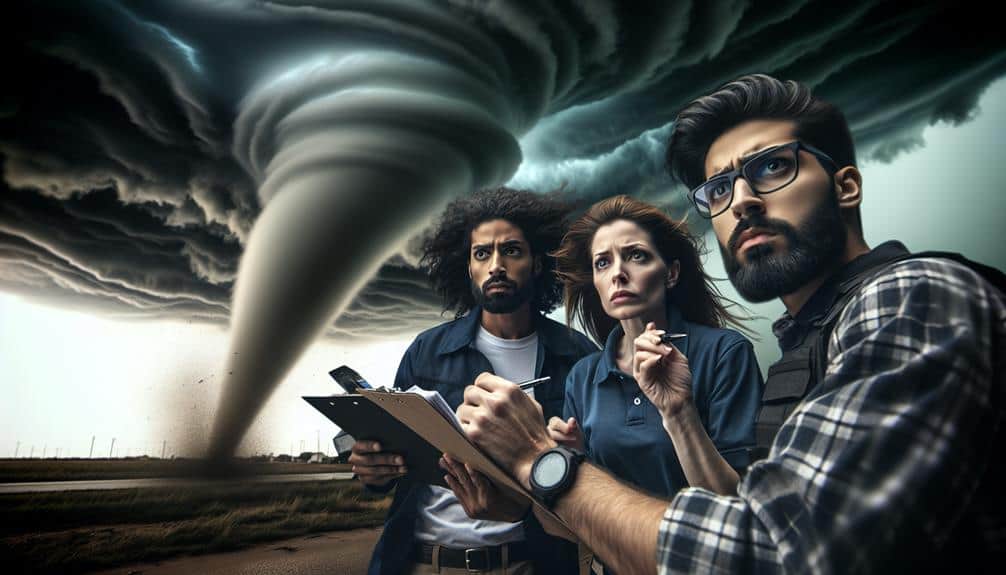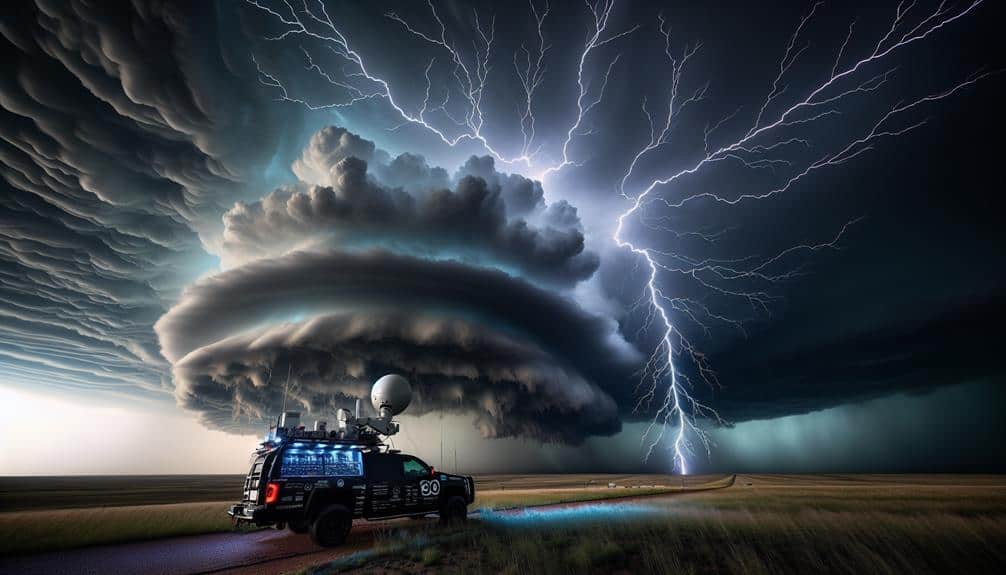In storm chaser reporting, we adhere to strict ethical guidelines to maintain accuracy, integrity, and public trust. We prioritize verifying information from multiple sources and balance speed with careful fact-checking. Our responsibility to public safety means providing timely updates without causing panic and respecting traffic laws. Avoiding sensationalism guarantees the severity of events is not distorted, and we respect privacy by obtaining consent and protecting individuals' anonymity when needed. Verifying sources and responsibly using visuals are essential for authentic reporting. If we follow these best practices, we guarantee an informed community while respecting ethical boundaries.
Key Points
- Verify all reported information through reliable sources to ensure accuracy before dissemination.
- Avoid sensationalism to maintain public trust and provide clear, precise information.
- Respect privacy rights by obtaining explicit consent before filming or photographing individuals.
- Prioritize public safety by providing timely and accurate updates without causing panic.
Accurate Information Dissemination
Securing precise information dissemination is crucial for storm chasers, as it directly impacts public safety and trust in media reporting. We must prioritize fact checking to secure our reports are both reliable and timely.
In the heat of the moment, it's easy to get caught up in the excitement and rush to share breaking news. However, responsible reporting demands that we verify all details before disseminating any information. This not only builds trust with our audience but also prevents the spread of misinformation.
Our role as storm chasers carries a significant ethical responsibility. We must thoroughly analyze the data we collect, cross-referencing with reliable sources to confirm its accuracy. By doing so, we maintain the integrity of our reports and uphold the trust placed in us by the public.
We've to balance speed with accuracy, securing that the information we provide isn't just fast, but also correct.
Freedom of information is paramount, but it comes with the duty to secure that what we share is factual. By committing to rigorous fact checking and responsible reporting, we can effectively contribute to a well-informed and safe community.
Prioritizing Public Safety
How can we as storm chasers effectively prioritize public safety while handling the challenges of real-time reporting?
First, we must recognize that our primary responsibility is to the communities we serve. By establishing strong community partnerships, we can ensure that our actions align with local emergency preparedness plans. These partnerships allow us to share critical information with local authorities and emergency services, enhancing the overall safety of the public.
We should also focus on providing timely and accurate updates without causing panic. Clear and concise communication helps the public make informed decisions. It's crucial that we use our platform to disseminate warnings and safety instructions from credible sources, such as the National Weather Service.
Additionally, we need to be mindful of our own safety and the safety of others on the road. Reckless behavior not only endangers us but also sets a poor example for the public. We should adhere to traffic laws and avoid obstructing emergency response efforts.
Avoiding Sensationalism
While prioritizing public safety remains paramount, we must also commit to avoiding sensationalism in our reporting. Sensationalism can distort the gravity of a storm event, leading to unnecessary panic and misinformation. Responsible reporting requires us to respect ethical boundaries, ensuring that the information we present is accurate and measured.
The impact of sensationalism is far-reaching. When we exaggerate the severity of a storm, we undermine public trust and potentially cause harm. Our audience deserves to make informed decisions based on factual, unbiased information. By focusing on ethical considerations, we uphold the integrity of our profession and contribute positively to public discourse.
Ethical boundaries in storm chasing reporting mean presenting data and visuals that are truthful and contextually relevant. We should avoid dramatizing situations for the sake of higher viewership or engagement. Instead, our commitment should lie in delivering clear, concise, and precise information. This approach not only respects our audience but also reinforces the importance of responsible reporting.
Respecting Privacy Rights
In our storm chasing reports, we must respect privacy rights by avoiding sensitive locations and ensuring consent for interviews.
It's essential to protect the anonymity of victims to prevent further trauma.
Avoiding Sensitive Locations
Storm chasers must diligently avoid delicate locations to honor the privacy rights of individuals affected by natural disasters. When we enter these environments, we must clearly define our ethical boundaries. This means steering clear of private properties and areas where individuals are especially susceptible, such as hospitals and shelters. Our goal should be responsible reporting, not sensationalism.
We recognize that capturing the impact of a storm is essential, but we must do so without infringing on the dignity of those affected. Respecting these boundaries ensures that we maintain the trust of our audience and the respect of the communities we cover. By avoiding delicate locations, we also reduce the risk of adding unnecessary stress to already traumatized individuals.
Furthermore, respecting privacy is an ethical imperative that aligns with the principles of journalistic integrity. We must balance our duty to inform the public with the need to protect individual rights. As storm chasers, we must always remember that our actions have real consequences for real people.
Consent for Interviews
Obtaining explicit consent for interviews is a fundamental aspect of respecting privacy rights in storm chaser reporting. When we interview victims or witnesses in the aftermath of a storm, we must prioritize their comfort and autonomy. Ethical factors play an essential role in these interview dynamics, guaranteeing that individuals aren't coerced or manipulated into sharing their experiences. By adhering to journalistic standards, we uphold the integrity of our profession and respect the dignity of those we interview.
Informed consent is more than just obtaining a verbal 'yes.' It involves clearly explaining the purpose of the interview, how the information will be used, and addressing any concerns the interviewee might have. This transparency fosters trust and promotes ethical journalism. We must remember that people affected by storms are often in vulnerable states; hence, respecting their privacy and obtaining informed agreement is paramount.
Additionally, maintaining high journalistic standards means we should never pressure individuals for immediate responses. Allowing them time to ponder their involvement respects their emotional and psychological state. By prioritizing ethical factors and informed agreement in our interview dynamics, we can make sure our reporting is both respectful and responsible.
Anonymity for Victims
Ensuring the anonymity of storm victims is important for protecting their privacy and maintaining ethical reporting standards. By not revealing victims' identities, we safeguard their dignity and prevent any potential misuse of their personal information.
Storm chasers, while capturing compelling footage and stories, must prioritize ethical reporting practices that respect the privacy rights of those affected by natural disasters.
We understand that our audience values freedom, including the freedom from unwanted exposure. Therefore, protecting identities becomes a fundamental aspect of responsible journalism.
When covering storm-related incidents, it's vital to avoid disclosing personal details unless explicit consent is given. This approach not only respects the victims' rights but also fosters trust between the media and the public.
Adhering to these principles requires a thoughtful balance. We should focus on the broader narrative of the storm's impact rather than individual suffering. By doing so, we can inform and educate without compromising ethical standards.
As storm chasers, we've a duty to report with integrity, ensuring that our quest for impactful stories never overshadows the humanity of those we cover. Protecting identities isn't just a guideline; it's a commitment to ethical journalism that honors the privacy of all individuals.
Verifying Sources

To maintain credibility in storm chaser reporting, we must rigorously verify our sources before disseminating information to the public. Fact checking and evaluating source credibility are essential to confirm that we provide accurate and trustworthy reports. In an age where misinformation can spread rapidly, our duty is to uphold high ethical standards.
We should consider the following practices when verifying sources:
- Cross-referencing information: Compare details from multiple reliable sources to confirm accuracy.
- Assessing source expertise: Confirm that sources have the necessary expertise or firsthand experience related to the storm event.
- Checking for biases: Identify any potential biases that could impact the source's reliability or objectivity.
- Validating visual content: Confirm the authenticity of photos and videos through metadata analysis and reverse image searches.
Ethical Video and Photo Use
When capturing videos and photos of storms, it is crucial to consider consent and privacy rights. This ensures that individuals' dignity is respected. Additionally, maintaining contextual integrity is important. This involves accurately representing the scenes without misleading alterations.
Balancing sensationalism with accuracy is essential to uphold the trust and reliability of our reporting.
Consent and Privacy Rights
Frequently, storm chasers must navigate the delicate balance between capturing compelling footage and respecting individuals' consent and privacy rights. It's essential we obtain informed consent whenever possible, ensuring we respect personal boundaries and ethical considerations. Our audience values freedom, and we must honor that by not infringing on privacy rights.
Respecting privacy rights involves more than just avoiding private property; it includes being mindful of individuals who may not want to be filmed or photographed.
Here are some best practices to keep in mind:
- Seek Informed Consent: Always ask for permission before filming or photographing individuals.
- Respect Boundaries: Avoid encroaching on personal spaces unless explicitly allowed.
- Obscure Identities: When consent isn't obtained, think about blurring faces to protect privacy.
- Ethical Considerations: Reflect on whether the footage serves the public interest without compromising privacy.
Contextual Integrity Maintenance
Maintaining contextual integrity in storm chaser reporting means we must guarantee that video and photo use aligns with the ethical expectations and social norms of the communities involved. We need to respect ethical boundaries and address privacy concerns diligently to uphold the trust of those affected by severe weather events. This involves being transparent about our intentions and ensuring that the images and footage we collect are used responsibly.
When capturing content, we must consider the potential impact on individuals' privacy. Are we intruding on private moments or spaces? If so, obtaining explicit consent isn't just a courtesy—it's a necessity. Additionally, we should be mindful of how these images might be perceived once disseminated to a broader audience. Misrepresentation or out-of-context use can lead to public misunderstanding and distress.
We also have to balance the necessity of documenting the event with the rights of the individuals involved. By setting clear ethical boundaries, we can navigate the fine line between public interest and personal privacy. Our role isn't just to document but to do so with integrity, ensuring that our reporting doesn't cause undue harm or violate the trust of the communities we aim to serve.
Sensationalism Vs. Accuracy
Balancing sensationalism and accuracy in storm chaser reporting is crucial to guarantee that our coverage informs the public without exaggerating or distorting the reality of severe weather events. We've a responsibility to maintain an ethics balance that ensures journalistic integrity while providing compelling content.
When we choose what footage or photos to share, it's vital to avoid manipulating images or selectively editing videos in ways that might mislead viewers. The goal should always be to present the situation as it is, without adding unnecessary drama. This approach respects our audience's right to accurate information and reinforces trust in our reporting.
Here are some best practices for ethical video and photo use:
- Avoid Misleading Edits: Ensure that any cuts or enhancements don't change the context or misrepresent the event.
- Fact-Check Visuals: Verify the authenticity of all images and videos before sharing them.
- Provide Context: Accompany visuals with accurate descriptions to avoid misinterpretation.
- Respect Privacy: Avoid showing individuals in distress without consent when possible.
Frequently Asked Questions
How Can Storm Chasers Balance Ethics With the Need to Report Quickly?
We can balance ethics with quick reporting by prioritizing public safety and transparency. Ensuring reporting accuracy and timeliness allows us to provide essential information without compromising ethical standards or the public's trust in our work.
What Training Do Storm Chasers Receive on Ethical Reporting?
We receive training on ethical dilemmas and reporting standards, focusing on balancing urgency with integrity. Our training requirements guarantee we're prepared to make quick, responsible decisions while respecting the freedom and safety of those we report on.
How Do Storm Chasers Handle Conflicts of Interest?
When we handle conflicts of interest, we follow strict disclosure requirements and transparency guidelines. We guarantee all relevant information is shared openly, promoting ethical standards and allowing the audience to make informed decisions without bias.
What Role Does Social Media Play in Ethical Storm Chaser Reporting?
Did you know 70% of storm chasers use social media? We face privacy concerns and verification challenges, but it's essential for information dissemination and public impact. Let's make sure our reporting respects privacy while informing and protecting communities.
Are There Industry Standards for Ethical Behavior Among Storm Chasers?
Yes, there are industry standards for ethical behavior among storm chasers. We must adhere to professional conduct and moral obligations, ensuring our actions respect public safety and the integrity of our reporting, while maintaining individual freedom.


